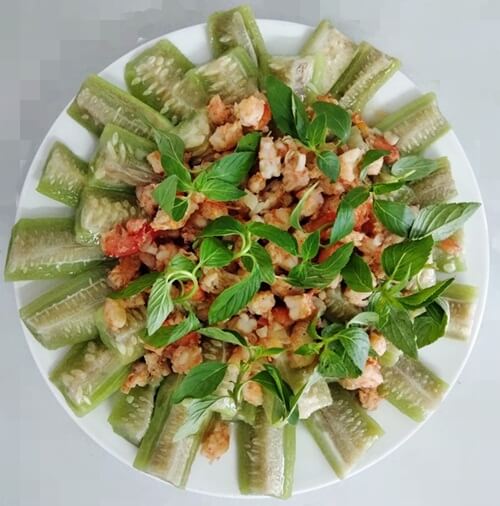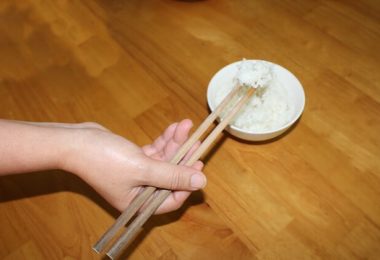Known in English as Vietnamese luffa, loofah, or Luffa cylindrica, and in Vietnamese as Mướp Hương, the sponge gourd is a humble yet versatile fruit. Affordable, delicious, and easy to cook, it is widely sold in markets across Vietnam—like the bustling Dong Ba Market in Hue—and is available almost year-round.
Beyond its culinary appeal, sponge gourd is a treasure trove of nutrients, offering surprising health benefits for women. Rich in Saponin, Fiber, Gum, Protein, Lysine, Arginine, Mannan, Aspartic Acid, Lignin, Glycin, Threonine, Fat, Glutamic Acid, Leucine, Iron, Manganese, Vitamins A, B, C, E, Potassium, Cucurbitacin B, Oleonolic Acid, and Neutral Sapogenin, it nourishes the body while delighting the palate.
1. When Not to Eat Sponge Gourd: A Gentle Guide for Travelers and Food Lovers
Sponge gourd, or loofah, isn’t just a refreshing ingredient in Vietnamese cuisine — it’s also packed with nutrients and carries notable medicinal benefits. However, for some, this gentle vegetable may not be the best choice. If you have allergies or are feeling unwell, it’s wise to steer clear. In such cases, loofah can aggravate symptoms or lead to discomfort, rather than healing.
And while sponge gourd pairs beautifully with many ingredients, there are two vegetables best enjoyed separately on your culinary journey:
- White Radish: Both loofah and white radish are nourishing and cooling on their own. But when eaten together, their combined “cold” nature can disrupt your body’s balance, especially if you’re sensitive to cooler foods — potentially leading to chills or digestive unease.
- Spinach: A beloved green in many dishes, spinach is rich in fiber and carbohydrates, and also has a cooling effect. When paired with sponge gourd, this duo can overstimulate the digestive system, possibly causing bloating, discomfort, or even diarrhea.
As you explore the vibrant flavors of Vietnam, enjoying dishes with loofah can be a refreshing delight — just be mindful of how and when to include it in your meals.
2. Sponge Gourd for Women
Many Vietnamese women have long cherished the sponge gourd (Mướp Hương) for its remarkable health benefits.
2.1. Boosting Milk Production
After childbirth, some mothers face low milk supply, soft or underfull breasts, or difficulty stimulating lactation. Nutritional support is key, and sponge gourd is celebrated for its milk-boosting properties. Daily consumption for 5–7 days can help restore milk flow.
In just 100 g of sponge gourd, there are 95 g of water, 0.8 mg of iron, 0.2 g of lipids, 3 g of glucose, 6.9 g of protein, 139 mg of potassium, 8 mg of vitamin C, and various B vitamins. These nutrients nourish the mother and enrich breast milk, supporting the baby’s growth.
How to use: Cook sponge gourd with pig’s leg or hoof, fish, or shrimp. Steaming or boiling also brings the desired benefits.
2.2. Relieving Clogged Milk
Sponge gourd can also help treat clogged milk. Include it in daily meals—soups, stir-fries, steaming, or boiling.
A simple method is to cook sponge gourd in filtered water with a pinch of salt and drink the water daily. Another traditional approach uses dried sponge gourd, burned, pureed, and mixed with a small amount of alcohol, then gently massaged onto the breasts to stimulate milk glands.
2.3. Easing Constipation and Hemorrhoid-Related Discomfort
Constipation is common during pregnancy and lactation. Sponge gourd provides a gentle, effective, and affordable remedy. Regular inclusion in meals—cooked with meat, fish, or shrimp, or simply boiled or steamed—can show results within 3–5 days.
Additionally, 30 g of sponge gourd flowers can be boiled into a daily drink for fast, safe relief from constipation, even easing bleeding caused by hemorrhoids.
2.4. Soothing Menstrual Discomfort
For women who experience heavy periods or abdominal pain during menstruation, sponge gourd offers gentle, natural relief. Containing compounds that help ease discomfort, it can make the monthly cycle more bearable. One of the most effective—and delicious—ways to use it is in a simple soup of sponge gourd and shrimp, enjoyed as part of a daily meal.
2.5. A Natural Skincare Treasure
From fruit to stem to leaf, the sponge gourd is a beauty ally. Its water helps smooth wrinkles, prevent signs of aging, treat acne and freckles, calm inflamed pores, and leave the skin radiant.
One method is to puree its leaves or fruit, extract the juice, and mix it with honey and egg before applying it to the face. After 30 minutes, rinse to reveal refreshed skin.
Another traditional technique uses water collected from the gourd’s trunk. After harvesting the fruit, cut the trunk about half a meter above the root. Place a clean jar beneath to catch the clear liquid that slowly drips out. Store this precious water in the refrigerator, and when needed, apply it to the skin for 30 minutes before rinsing. This simple yet effective cosmetic has been cherished for generations.
The Vietnamese luffa, or sponge gourd, is a humble yet beloved ingredient in everyday meals—affordable, nourishing, and full of benefits, especially for women. Adding it to your daily menu is a simple choice that can bring lasting wellness.
With its mild, refreshing flavor and tender crunch, the sponge gourd is easy to prepare and enjoy. Whether simmered into a sweet, cooling soup, stir-fried with shrimp, gently steamed, or simply boiled, it brings a touch of wholesome Vietnamese comfort to the table.
Keep these valuable uses in mind and turn to this versatile fruit whenever you need a gentle boost for health and beauty.
Note: The methods described are for reference only. Please use them at your own discretion.





